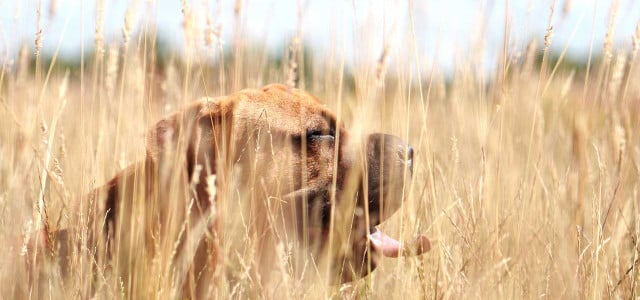
Dogs love to romp through meadows and fields. But a great danger lurks there: awns, as the Four Paws organization warns. In the worst case, the damage can be life-threatening. You can find out how to protect your dog here.
A dog rampaging across a cornfield – which sounds idyllic, could actually harm four-legged friends. The Animal Welfare Foundation Four Paws warned in a press release as early as 2022: Awns, i.e. the bristle- or thread-like plant parts of cereals and other meadow plants, can pose a danger to dogs and, in the worst case, lead to the death of the animal.
Because the plant parts have small barbs that can get caught on the dog’s body. According to the press release, once the awns have settled in the dog’s fur, they penetrate deeper with every movement. Once the parts of the plant have penetrated the dog’s skin, they can cause infection, inflammation or abscesses in the affected area. When romping around, dogs could also swallow awns or ingest them through their noses and ears. The animal protection organization warns that the foreign bodies can then migrate through the gastrointestinal tract and the respiratory tract, for example, and cause life-threatening damage there.
Protect dog from awns: You can do that
If you want to protect your four-legged friend from awns, you should take a few precautionary measures. Sarah Ross, pet expert at Vier-Pfoten, advises not to let the dog run through tall grass or cornfields at the moment.
In addition, according to the expert, you should:
- keep the fur short, especially on the paws,
- brush out the undercoat as well
- check the dog for awns after every walk.
If you find awns that have only slightly penetrated the skin, Ross advises removing them with tweezers. “However, if an awn is already deeper in the skin, the dog must immediately seek veterinary treatment so that the awn can be removed there and the dog can be given anti-inflammatory and pain-relieving medication.”
How to recognize awn infestations in dogs
Awns cannot always be seen with the naked eye – depending on the spot, the dog shows different symptoms.
For example, awns often dig in between the toes on the paw. If this happens, the dog will lick and bite its paw or may limp. When the awn moves into the paw, a small hole can be seen at the point of entry from which secretion leaks.
“If it’s in his ear, he shows it by scratching his ear or shaking his head frequently. It can also happen that the dog tilts its head and smelly liquid escapes from the ear,” explains Sarah Ross from Vier-Pfoten.
“Awns in the nose can trigger sneezing, nasal discharge or nosebleeds. If awns travel through the dog’s nose and trachea to the lungs, this leads to sudden and persistent coughing or shortness of breath: there is an absolute danger to the dog’s life.”
If the dog scratches its eyes more often, this could be a sign that awns have settled there. According to Vier-Paws, tears and sensitivity to light are also symptoms of foreign bodies in the eye.
Of course, the symptoms can also have other causes. Nevertheless, Sarah Ross recommends a visit to the vet, “because the consequences can range from harmless abscesses or infections to middle ear infections or pneumonia and, in the worst case, the death of the animal”.
Incidentally, awns are not only a danger for dogs, but also for cats. According to the animal welfare organization TASSO, the symptoms are very similar – cat fur from free cats should also be checked and a veterinarian should be consulted if an awn infestation is suspected.
Read more on Techzle.com:
- Heat wave & dog: do’s and don’ts for the hot days
- Dog ice cream: How to make ice cream for dogs yourself
- 8 tips to minimize your dog’s carbon footprint